eCommerce: Key Performance Indicators
Cart Abandonment Rate in Europe: Country Statistics, Consumer Behavior & Shipping
Discover why European shoppers abandon online carts. Learn how delivery details impact purchases. Hint: Low shipping costs and smooth checkout are key to making them buy.
Article by Cihan Uzunoglu | May 23, 2024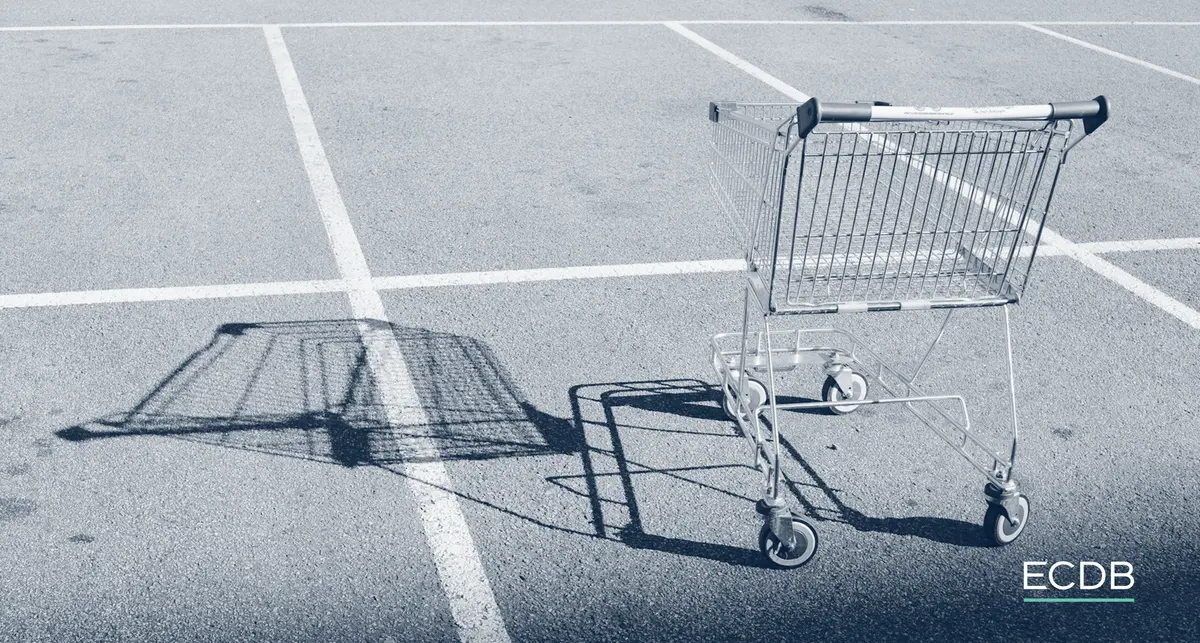
Cart Abandonment Rate in Europe: Key Insights
Shipping Costs Impact: Half of the European shoppers cite high delivery costs as the primary reason for cart abandonment, highlighting the need for transparency in shipping fees.
Delivery Preferences: In Spain, 72% of shoppers prefer delivery costs included in the item price, contrasting with Poland where 64% favor seeing options at checkout, showcasing diverse expectations across Europe.
Checkout Process: Simplified checkout and flexible delivery options are crucial, with 67% of Austrians abandoning carts due to lack of preferred delivery choices, underscoring the importance of adapting the checkout experience to reduce abandonment rates.
Ever filled up an online shopping cart only to leave it behind? You’re definitely not the only one. People might be ready to buy, but then they see the shipping costs or can't find their preferred delivery option and decide not to. It's not just about the extra fees either. Sometimes, how shipping costs are shown or the lack of choice at checkout can make or break the deal.
Why does this matter? Because understanding why people ditch their carts can help online stores fix these issues.
What is Cart Abandonment?
Cart abandonment occurs when online shoppers add products to their shopping cart but exit the site without finalizing their purchase. This common issue can arise from high shipping costs, complex checkout processes, or the lack of preferred payment options.
Recognizing these factors is essential for eCommerce businesses to enhance customer experience, increase conversion rates, and minimize cart abandonment.
Cart Abandonment Rate in Europe:
Average is 80%
Based on our 2023 data:
Bulgaria has the highest cart abandonment rate in Europe at nearly 85%.
Romania, Croatia, Greece, Portugal, Serbia and Italy follow, all with around 83%.
Rounding out the top 10, cart abandonment rates of Russia, Poland and Turkey are at around 82%.
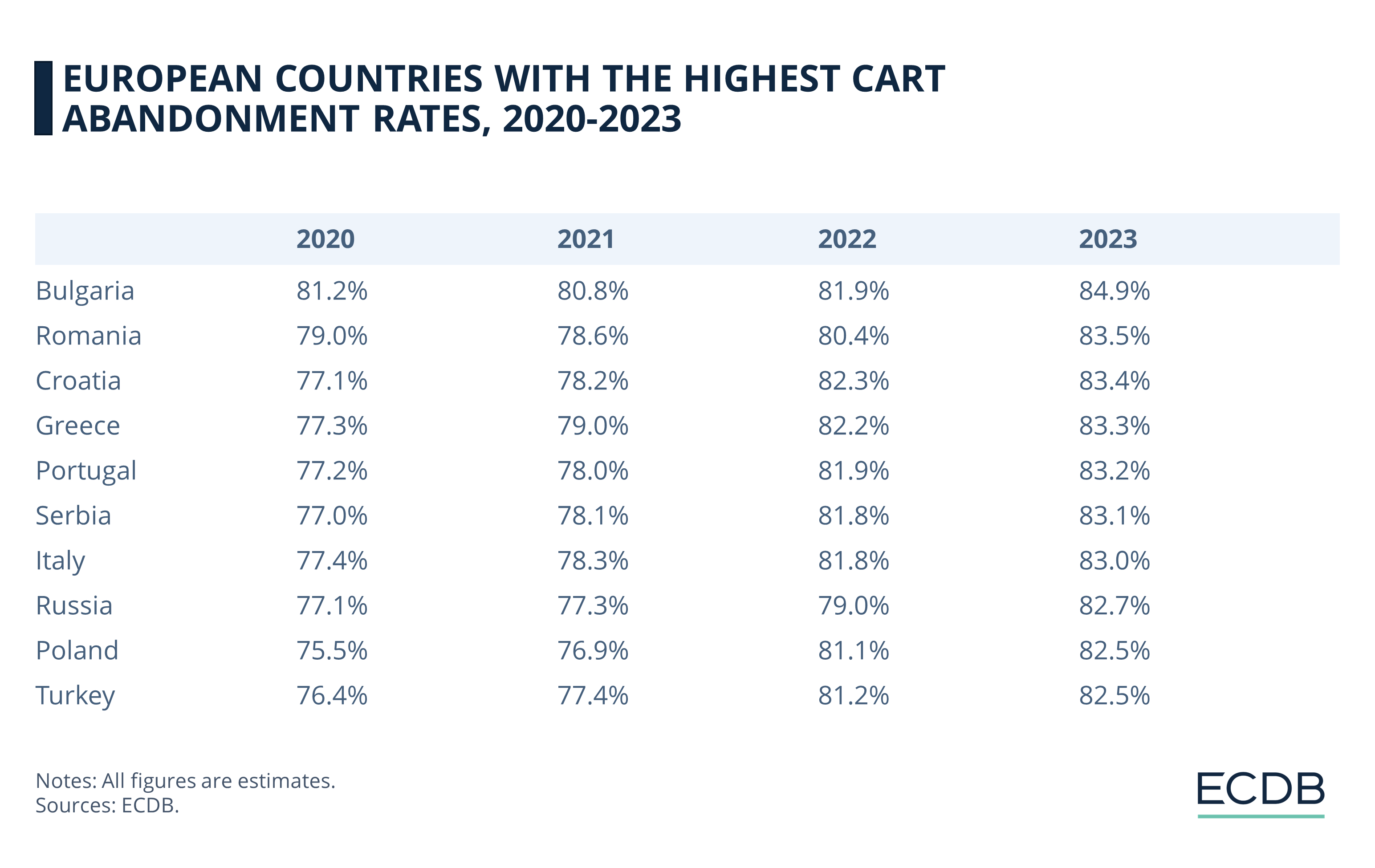
Regarding the European average, the cart abandonment rate has been increasing consistently. 2020’s 75% stayed more or less the same with 75.3% in 2021. Next year, in 2022, this figure went up to 78.4%, before making another significant jump to 80.2% last year.
But, aside from differences between countries, why do shoppers abandon their carts at all?
For your information: We regularly update our rankings with the latest data from our models, providing valuable insights to help improve your company. Which stores and companies are leading eCommerce? Which categories are driving bestsellers and high sales? Find out for yourself on our rankings for companies, stores, and marketplaces. Stay a step ahead of the market with ECDB.
Cart Abandonment Reasons in Europe
It goes without saying that it’s important to know what consumers want. In this regard, there are several factors that contribute to cart abandonment. Extra costs, such as shipping fees, are a major deterrent for shoppers, with the total cost of items being higher than anticipated, leading to the abandonment of carts.
Slow website loading times, the requirement to create a user account before checkout, and preferred shopping times, especially during weekends when cart abandonment peaks, also play significant roles. Interestingly, retargeting strategies such as offering discounts have been seen to encourage millennials to complete purchases of previously abandoned items.
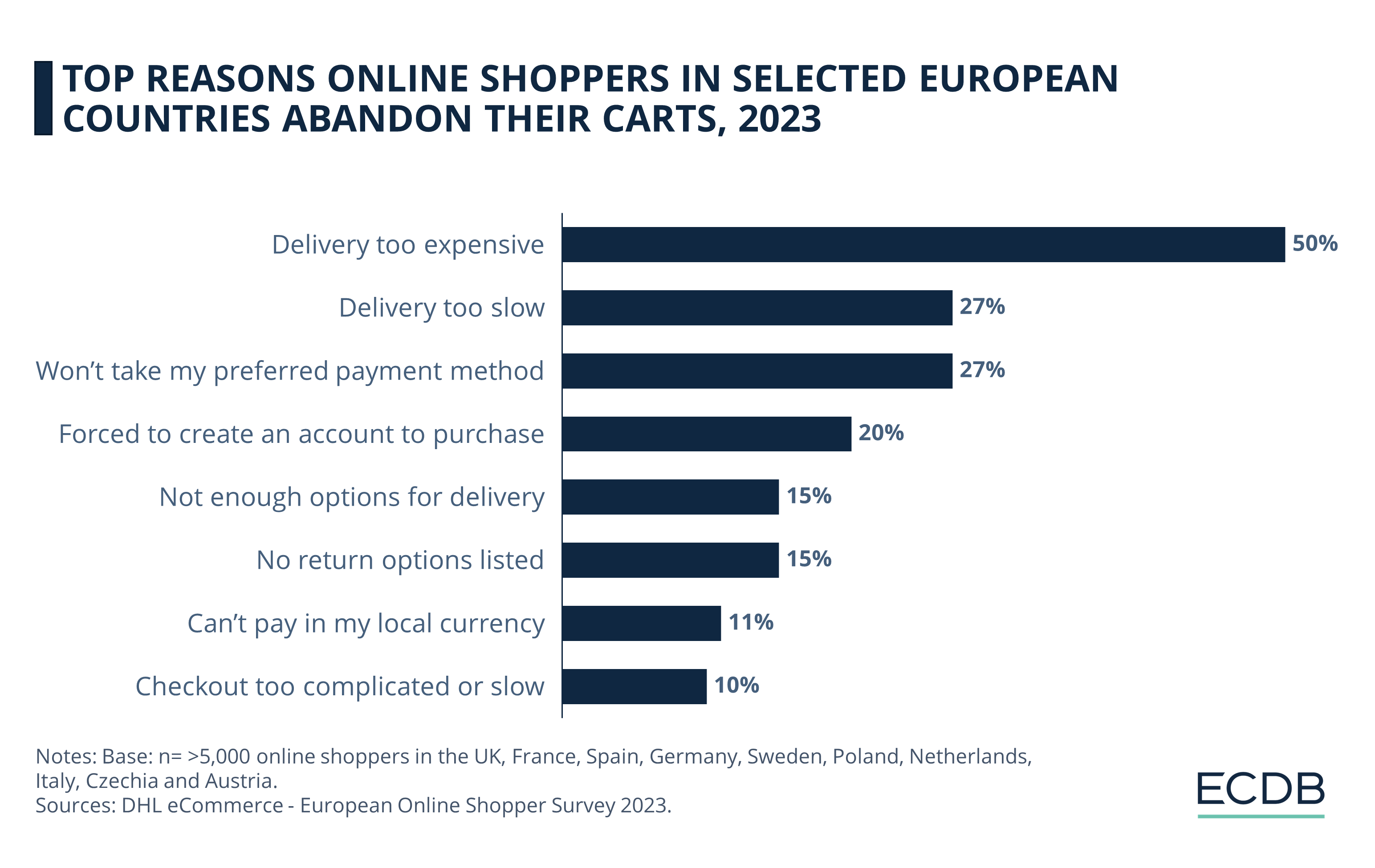
Shedding light on the nuances behind these behaviors, data from DHL’s European Online Shopper Survey 2023 offers valuable perspectives. Based on surveys done in the UK, France, Spain, Germany, Sweden, Poland, Netherlands, Italy, Czechia and Austria:
The most cited cart abandonment reason is the high cost of delivery, with 50% of respondents indicating this as a deal-breaker.
Another significant factor is delivery speed, with 27% of shoppers backing out of purchases due to slow delivery times.
Equally, the lack of preferred payment methods also accounts for 27% of cart abandonments.
The survey further points out that 20% of online shoppers are deterred by the requirement to create an account to make a purchase.
Additionally, 15% of respondents were turned off by insufficient delivery options and the absence of clear return policies.
While 11% of shoppers abandoned their carts because they could not pay in their local currency,
10% of respondents found the checkout process either too complicated or too slow.

Delivery Costs: Included in Price or
See Options at Checkout?
As exemplified by the fact that half of cart abandonment reasons mentioned in the previous section are directly shipping related, it is clear that shipping is an essential factor for online businesses to consider when it comes to cart abandonment. Shoppers in different markets also diverge in how they want delivery costs to be handled – either included in item cost or see options at checkout.
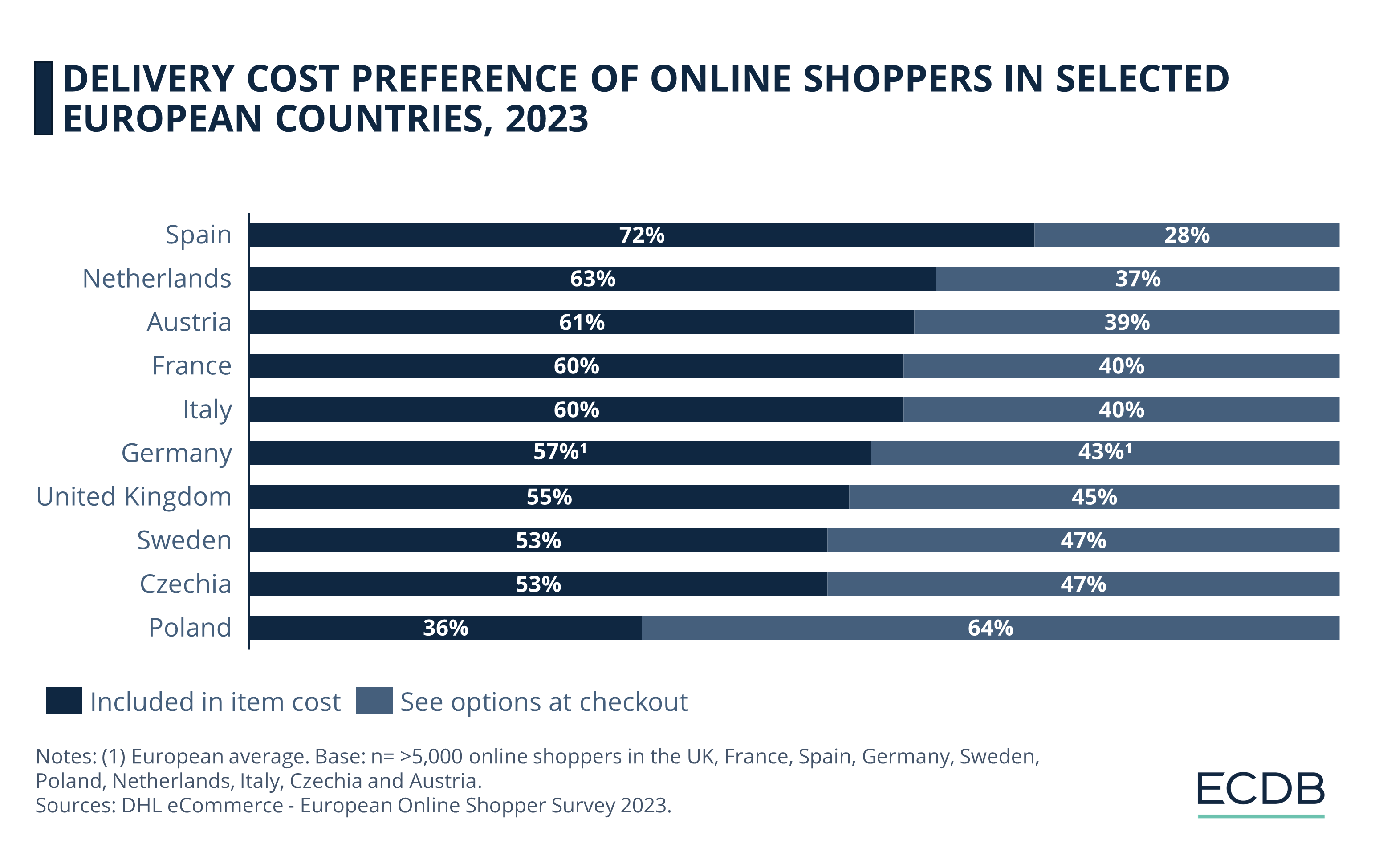
Regarding how different European countries approach this question, Spain leads the preference for having delivery costs included in the item cost, with a significant 72% of respondents favoring this approach. On the other end of the spectrum, Poland stands out with a clear preference for seeing delivery options at checkout, with 64% of respondents leaning towards this choice, suggesting a more flexible shopping culture where options and choices at the final stages of purchasing are valued.
The Netherlands, Austria, France and Italy also show a stronger preference for delivery costs to be included in the item's cost. Countries like Germany (representing the European average perfectly), the United Kingdom, Sweden, and Czechia show a more divided opinion, leaning slightly towards inclusion of delivery costs in the item's price, but with a significant portion of the population still preferring to see options at checkout.
Delivery Options’ Role in Cart Abandonment
Simplified checkout processes are crucial in reducing cart abandonment, especially when it comes to delivery options. As findings from the DHL report suggest, shoppers from certain European countries are less forgiving when they see that their preferred delivery options are not offered by retailers.
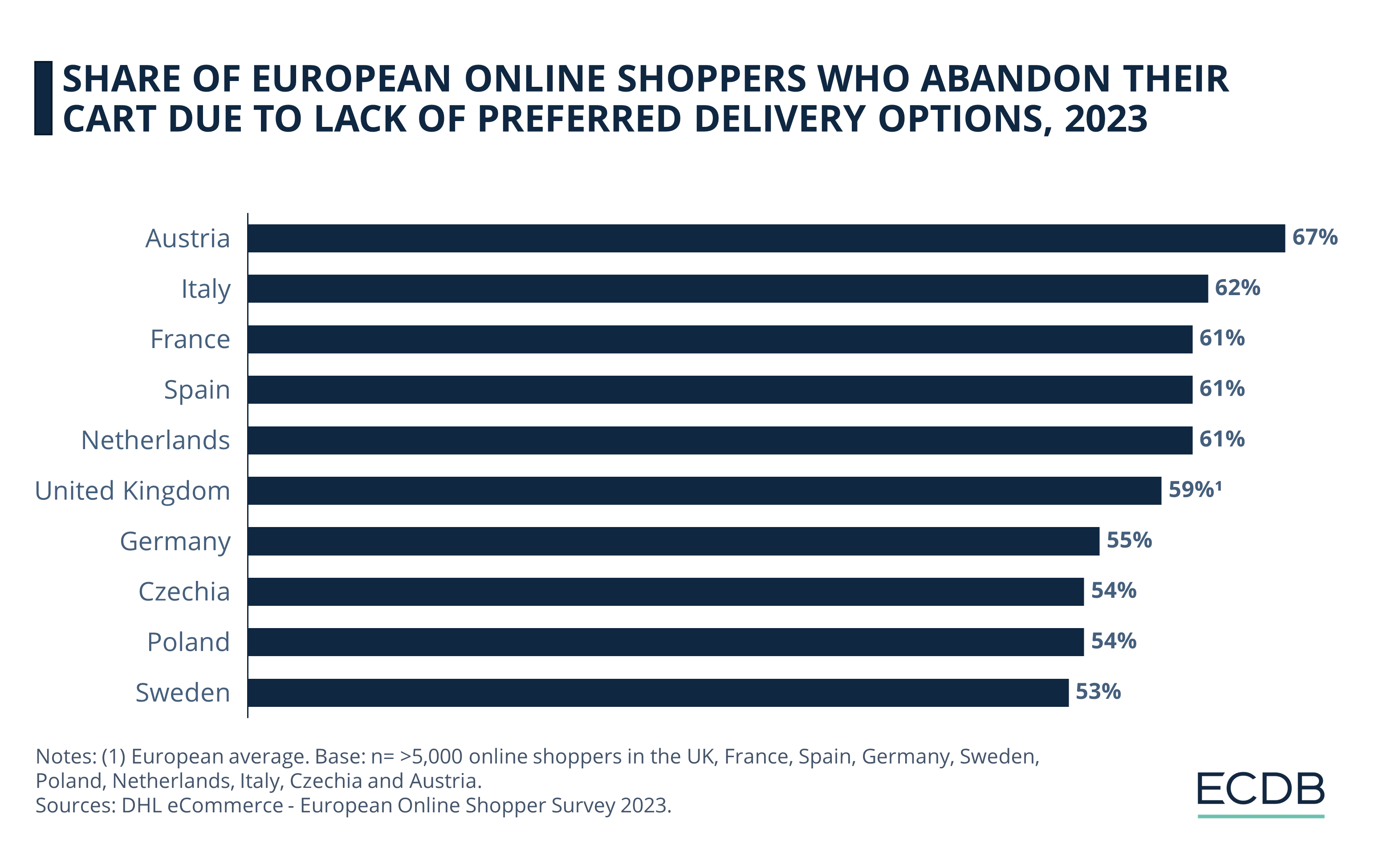
Austria leads the pack, with 67% of online shoppers abandoning their carts due to the lack of preferred delivery options.
At the other end, Sweden shows the lowest tendency, with 53% of shoppers citing this reason for cart abandonment.
While Italy, France, Spain and the Netherlands are above the European average in this regard, the United Kingdom sets the standard with 59%.
Germany, Czechia and Poland, on the other hand, lean more towards a more tolerant approach like Sweden.
Reducing Cart Abandonment:
Closing Thoughts
To tackle cart abandonment in Europe, it's essential for retailers to clearly outline shipping costs and offer flexible delivery choices upfront. High abandonment rates, especially in industries dealing with high-value items or complex purchases, underline the need to sweeten the shipping options for customers. Incentives like free shipping, transparency about costs, and a range of delivery options play a significant role in reducing abandonment. Trust in the shipping process is critical; shoppers want assurance on delivery speed, reliability, and affordability.
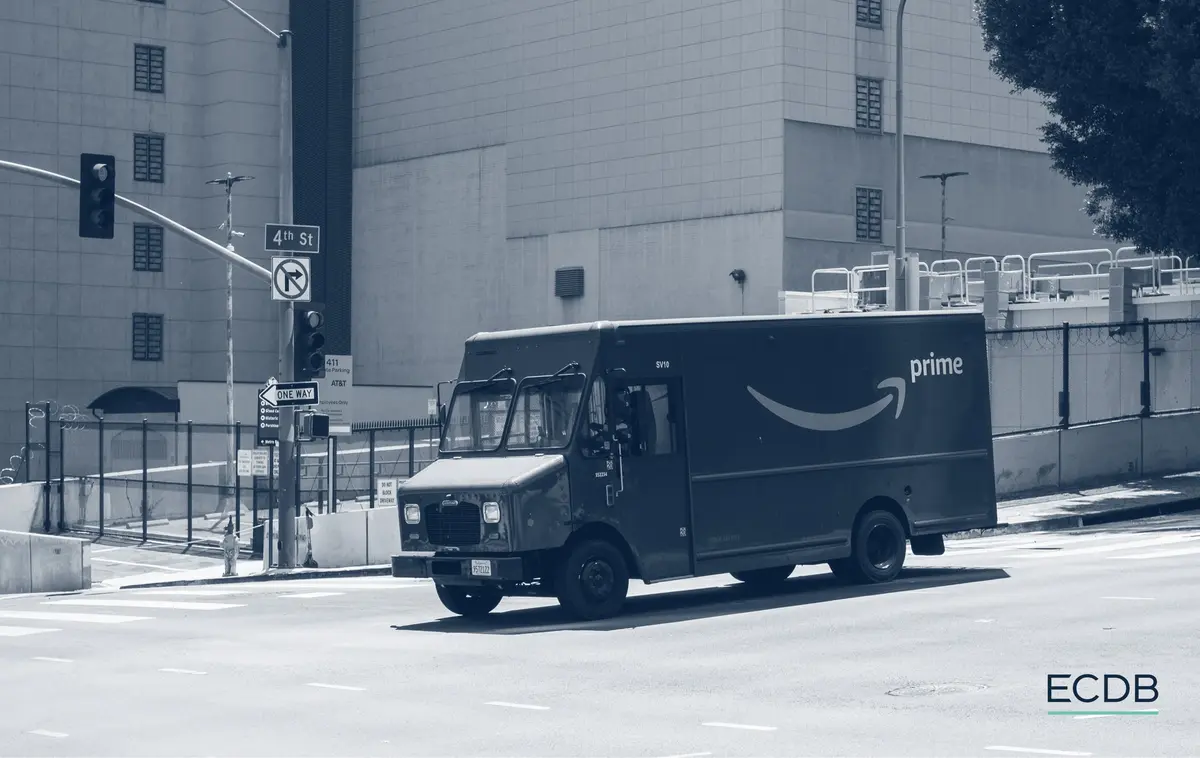
Beyond shipping, addressing other critical factors like payment flexibility and return policies is also key to reducing cart abandonment. Enhancing the online shopping experience means ensuring a seamless payment process that supports multiple methods and clear, customer-friendly return policies.
These elements, along with a simplified checkout process and transparent communication from the start, are fundamental in meeting consumer expectations, minimizing cart abandonment, and fostering a more positive shopping environment.
Sources: DHL, SaleCycle, 99Firms, TechReport, ECDB

Click here for
more relevant insights from
our partner Mastercard.
Related insights
Deep Dive
eCommerce in Indonesia: Revenues Projected to Cross US$100 Billion in 2025
eCommerce in Indonesia: Revenues Projected to Cross US$100 Billion in 2025
Deep Dive
eCommerce in Europe: Top Cross Border Countries & Consumer Trends
eCommerce in Europe: Top Cross Border Countries & Consumer Trends
Deep Dive
Buy Now, Pay Later (BNPL) in the U.S: Top Providers, Market Analysis & Consumer Behavior
Buy Now, Pay Later (BNPL) in the U.S: Top Providers, Market Analysis & Consumer Behavior
Deep Dive
Turkish eCommerce: Top Online Stores, Market Development & Quick Commerce
Turkish eCommerce: Top Online Stores, Market Development & Quick Commerce
Deep Dive
Brazil eCommerce Market: Top Stores, Revenue & Market Trends
Brazil eCommerce Market: Top Stores, Revenue & Market Trends
Back to main topics